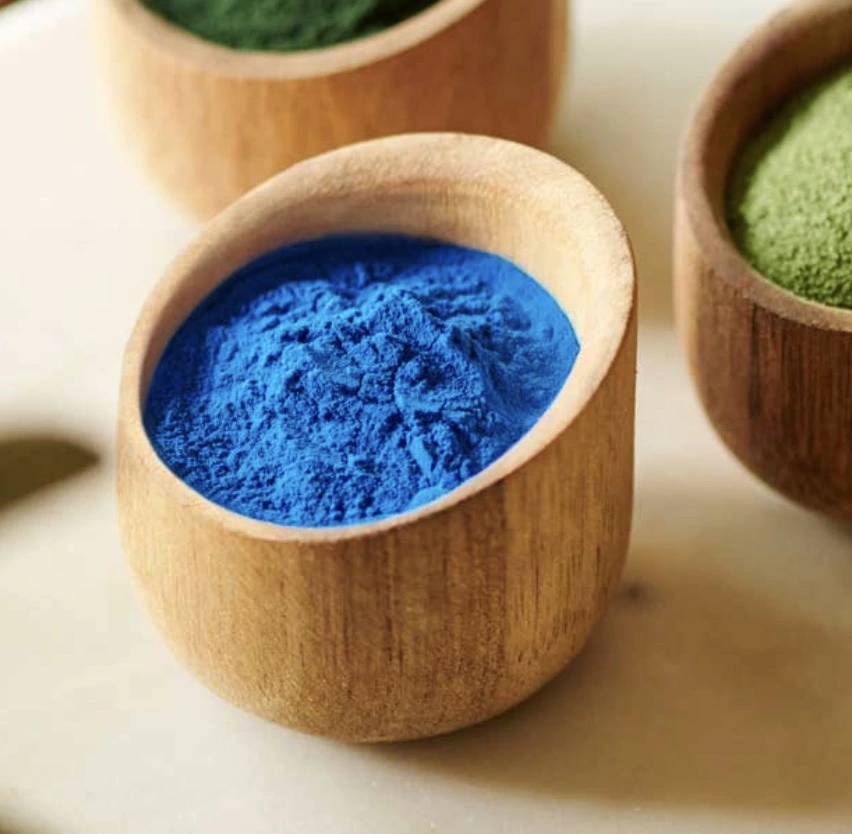What is the difference between meso zeaxanthin and zeaxanthin?
In the realm of eye health and nutrition, two carotenoids often take center stage: meso zeaxanthin and zeaxanthin. While these compounds share similarities, they also have distinct characteristics that set them apart. Understanding the difference between meso zeaxanthin powder and zeaxanthin is crucial for those looking to optimize their ocular health through supplementation or dietary choices.

Meso Zeaxanthin Powder vs Zeaxanthin in Supplements
When it comes to supplements, both meso zeaxanthin and zeaxanthin are available, often in powder form. However, there are key differences in their sourcing, structure, and potential benefits.
Chemical Structure and Origin
Zeaxanthin is a naturally occurring carotenoid found in various fruits and vegetables. It has a specific molecular structure that allows it to be absorbed by the body and deposited in the macula of the eye. Meso zeaxanthin, on the other hand, is a stereoisomer of zeaxanthin. This means it has the same chemical formula but a slightly different arrangement of atoms.
Interestingly, while zeaxanthin is abundant in nature, meso zeaxanthin is rarely found in dietary sources. The human body primarily produces meso zeaxanthin by converting lutein in the retina. This unique characteristic makes meso zeaxanthin powder supplements particularly valuable for those looking to boost their macular pigment optical density (MPOD).
Absorption and Bioavailability
Both meso zeaxanthin and zeaxanthin powders can be formulated for optimal absorption. However, their bioavailability may differ. Meso zeaxanthin, being less common in the diet, may have a more pronounced effect when supplemented directly. This is because the body doesn't need to convert it from other carotenoids, potentially leading to more efficient uptake in the retina.
Zeaxanthin, while more prevalent in foods, still offers excellent bioavailability in supplement form. Many high-quality zeaxanthin powders are designed to enhance absorption, often utilizing advanced technologies like microencapsulation or emulsification.
Supplement Formulations
When comparing meso zeaxanthin powder to zeaxanthin supplements, it's important to note that many eye health formulations combine multiple carotenoids. For instance, a supplement might include:
- Meso Zeaxanthin Powder (5%, 10%, 20%, 70%, or 80% concentration)
- Zeaxanthin (typically in similar concentrations)
- Lutein (another crucial macular carotenoid)
These combinations aim to provide a comprehensive approach to macular health, leveraging the synergistic effects of these carotenoids. The specific ratios and concentrations can vary, with some formulations boasting purities as high as 98% or even 99%.
Production and Quality Control
Both meso zeaxanthin and zeaxanthin powders undergo rigorous production processes to ensure purity and potency. High-quality supplements often feature:
- Non-GMO and non-irradiated ingredients
- Compliance with European standards for PAH4 and Benzopyrene levels
- Third-party laboratory testing for quality assurance
- ISO, HACCP, Kosher, and Halal certifications
These quality control measures are crucial for ensuring the safety and efficacy of both meso zeaxanthin and zeaxanthin supplements.

Why Meso Zeaxanthin Is Essential for Macular Health?
While both meso zeaxanthin and zeaxanthin contribute to eye health, meso zeaxanthin plays a unique and essential role in maintaining macular integrity.
Concentrated Distribution in the Macula
Meso zeaxanthin is predominantly found in the central part of the macula, known as the fovea. This region is responsible for our sharpest and most detailed vision. The concentration of meso zeaxanthin in this critical area suggests its importance in protecting the most vulnerable and functionally significant part of our retina.
Superior Antioxidant Properties
Research indicates that meso zeaxanthin powder may have superior antioxidant properties compared to other macular carotenoids. Its unique structure allows it to quench singlet oxygen more efficiently, potentially offering enhanced protection against oxidative stress in the retina.
Complementary Action with Other Carotenoids
Meso zeaxanthin works in concert with lutein and zeaxanthin to form a protective layer in the macula. This trio of carotenoids, often referred to as the macular pigment, acts as a natural sunscreen for the eye, filtering harmful blue light and neutralizing free radicals.
Potential Benefits for Age-Related Eye Conditions
Several studies have explored the potential benefits of meso zeaxanthin supplementation in age-related macular degeneration (AMD) and other eye conditions. While more research is needed, early results suggest that meso zeaxanthin, particularly when combined with other macular carotenoids, may help improve visual function and protect against further deterioration in individuals with AMD.
How Meso Zeaxanthin Powder Works in the Retina?
Understanding the mechanism of action for meso zeaxanthin powder in the retina helps illuminate its unique benefits and how it differs from zeaxanthin.
Selective Accumulation in the Fovea
When consumed as a supplement, meso zeaxanthin powder is absorbed into the bloodstream and selectively accumulated in the foveal region of the retina. This targeted deposition is crucial, as the fovea is responsible for our most acute vision and is particularly vulnerable to damage from light and oxidative stress.
Blue Light Filtration
Meso zeaxanthin, along with lutein and zeaxanthin, forms a yellow pigment in the macula. This pigment acts as a natural filter, absorbing harmful blue light before it can damage the sensitive photoreceptor cells in the retina. The unique structure of meso zeaxanthin allows it to absorb slightly different wavelengths of light compared to zeaxanthin, providing more comprehensive protection.
Free Radical Neutralization
As a powerful antioxidant, meso zeaxanthin helps neutralize free radicals in the retina. These unstable molecules can cause oxidative damage to cells, contributing to the development and progression of eye diseases. By quenching free radicals, meso zeaxanthin helps maintain the health and function of retinal cells.
Enhancement of Visual Performance
Some studies suggest that increasing macular pigment density through meso zeaxanthin supplementation may lead to improvements in visual performance. This includes potential benefits in:
- Contrast sensitivity
- Glare recovery
- Visual acuity under low light conditions
These improvements may be particularly noticeable in individuals with initially low macular pigment levels.
Synergistic Effects with Other Carotenoids
While meso zeaxanthin has unique properties, its full potential is often realized when combined with lutein and zeaxanthin. This triad of carotenoids works synergistically, each contributing to the overall health and function of the macula. The precise ratios found in high-quality supplements aim to mimic the natural distribution of these carotenoids in a healthy retina.

Conclusion
In conclusion, while both meso zeaxanthin and zeaxanthin are valuable carotenoids for eye health, meso zeaxanthin's unique properties and concentrated presence in the fovea make it an essential component of comprehensive eye care supplementation. As research continues to unfold, the specific benefits of meso zeaxanthin powder in maintaining and potentially improving visual function become increasingly clear.
For those interested in exploring high-quality meso zeaxanthin and zeaxanthin supplements, Yangge Biotech Co., Ltd. offers a range of natural plant extracts and powders tailored for optimal eye health. Our products are backed by rigorous quality control measures and certifications to ensure purity and efficacy. To learn more about our meso zeaxanthin powder and other eye health solutions, please contact us at info@yanggebiotech.com.
References
1. Bernstein, P. S., Li, B., Vachali, P. P., Gorusupudi, A., Shyam, R., Henriksen, B. S., & Nolan, J. M. (2016). Lutein, zeaxanthin, and meso-zeaxanthin: The basic and clinical science underlying carotenoid-based nutritional interventions against ocular disease. Progress in Retinal and Eye Research, 50, 34-66.
2. Nolan, J. M., Power, R., Stringham, J., Dennison, J., Stack, J., Kelly, D., ... & Beatty, S. (2016). Enrichment of macular pigment enhances contrast sensitivity in subjects free of retinal disease: Central Retinal Enrichment Supplementation Trials–Report 1. Investigative Ophthalmology & Visual Science, 57(7), 3429-3439.
3. Khoo, H. E., Ng, H. S., Yap, W. S., Goh, H. J., & Yim, H. S. (2019). Nutrients for prevention of macular degeneration and eye-related diseases. Antioxidants, 8(4), 85.
4. Arunkumar, R., Calvo, C. M., Conrady, C. D., & Bernstein, P. S. (2018). What do we know about the macular pigment in AMD: the past, the present, and the future. Eye, 32(5), 992-1004.
5. Chew, E. Y., Clemons, T. E., Agrón, E., Sperduto, R. D., Sangiovanni, J. P., Davis, M. D., & Ferris, F. L. (2014). Ten-year follow-up of age-related macular degeneration in the age-related eye disease study: AREDS report no. 36. JAMA Ophthalmology, 132(3), 272-277.

Based on your location and order quantity, you will have the opportunity to receive a limited time free shipping promotion!

Who we are


